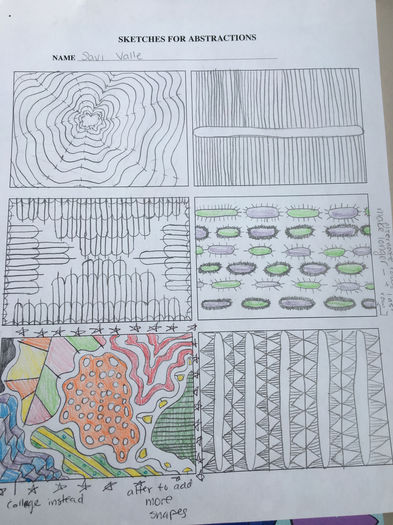
201 STUDIO ASSIGNMENT
1E: analyzes + demonstrates the elements and principles of design.
DESCRIPTION:
These are pieces I made in my Fall Semester 2018 at Illinois State for my Ceramics II class. This was a part of my final project for that class, which was to create a set of connected ceramic pieces (minimum 5 works)that portray a consistent theme and level of craftsmanship.
RATIONALE:
These works address many elements and principles of design. Being round objects- aka thrown on the wheel- they embody the movement and rhythm as the pieces have no edges it allows the eye to follow design and the shape. There is a factor of unity in that they are collected as a cohesive body of work. There are textures on each of the pieces.In relation to this standard, I feel it is important to show that as an artist I can show examples of design. Not only to show my knowledge but also to teach my students in my own work.

Describe your image

Describe your image


Describe your image
ARTIST STATEMENT:
This is a body of work. It was created as a dish set for my mother. The images included were taken before the bisque firing, so the clay is colored with an underglaze inlay or coat. The body of work contains dragonfly motifs. Throughout the pieces, there are dragonfly wings and textures that are intended to embody the texture and naturalness that accompanies an insect. These pieces are to critique the beauty that artists can represent. This work- and the body itself is inspired by ceramic artist Anna Collette Hunt, and her series of insects titled "Stirring the Storm". I was inspired by how Hunt takes insects and creates them out of clay and multiplies them so at first look they are beautiful designs however, they are made out of beetles and roaches- the more "disgusting insects".
ANALYSIS OF ARTWORK
1F: analyzes + demonstrates how aesthetic qualities are used in art work
1G: analyzes + evaluates artwork for how aesthetic qualities are used to convey intent, expressive ideas, and/or meaning.
DESCRIPTION:
These are a series of prints based on a drawing of the man-made world. I chose to draw my room focusing on the ceiling fan and closet doors. I wanted to create an interesting perspective instead of just looking straight up at the fan in order to incorporate more aspects of the room, than just the fan. After sketching I traced my drawing onto a styrofoam plate and then used that as my printing plate. I wanted to create a series of prints that were different in appearance at first glance, but still can be seen as a cohesive work of art. That is why I chose to use a group of colors and keep that and the print consistent.
RATIONALE:
By choosing this work of art I can demonstrate in my work that I understand aesthetic qualities and how to use and analyze them in a work of art. In my piece, I had to make decisions about how to lay the print, did I want them to all be the same, did I want to use the same color or different colored inks.As a requirement in our studio assignments we had to analyze our work, declare the decisions we made, and also talk about what we would have done differently. These are all ways to analyze your work and is a great project to teach students the same. Printmaking requires a lot of decision making that we don't attribute to it at first glance, however, it is a great process to use to teach students about intent of ideas and how to express aesthetic qualities.
STUDIO ARTWORK WITH CONCEPT DEVELOPMENT WORK
4F: creates artwork that demonstrates the process for problem solving + creative exploration
EVIDENCE: Above are images that depict the process of an Abstraction project for ART 201
DESCRIPTION:
For this project, we were required to look at various natural objects and sketch three that we like- or three perspectives of the same item. Then brainstorm ideas for how to abstract our drawings. Then we created a final abstraction based off of our original drawing. I chose to do a collage with colored construction paper and marker. My abstraction was based off a drawing I did of an intricate shell. The images above depict the process es of drawings, to thumbnail sketches, to final piece.
RATIONALE:
This project is a great way to demonstrate the process of problem solving all artists face in creating works of art. By showing drawings, sketches, and the final piece work shows the process and decisions made to get there. This abstraction leave room for a lot of creative exploration in mediums and how to even create an abstract piece from a natural object. I was required to draw and then think about how I could create an abstract piece from an observational drawing. There are many approaches to abstraction and a lot of problems can arise in abstraction. However, by brainstorming using thumbnails can show you an idea of how it might look and you can determine from those thumbnails which ideas you like and want to take further by finalizing into your final piece. These are all great processes which can show students that artists are not impulsive and even those people who have made art for years run into problems and need to think and reevaluate what they want to do with their art, in order to put the best piece of work on display.
CLINICAL OBSERVATION WRITTEN REFLECTION
7A: understands child development +the phsychological principles of learning + how they apply to visual arts education
DESCRIPTION:
The attached PDF file is a paper based on my clinical observations and how I saw child development in the classroom. It talks about the how the textbook Children And Their Art explains artist development and the factors to how children mind change towards art., while also backing that up by using real classroom observations. With both of those there was a solid understanding of how children's brains work and develop as they grow older, and how those factors effect the art making process.
RATIONALE:
After observing and reading the textbook, I gained a lot of insights into how students brain not only work but develop. In the paper there are concrete examples of how lessons were changed for different age groups. How younger kids worked with art compared to older students and why there was a difference in the art they make. Also what factors contribute to the shift in art as students get older.
PROFESSIONALISM, ADVOCACY, & LEADERSHIP (PAL 1)
7G: understands the need for continuing study, self evaluation, + professional growth
DESCRIPTION:
Del Harrow is a growing ceramic artist and art educator based in Fort Collins, Colorado. Del was an amazing artist to watch as he is talented in the medium and it was nice to see someone stray away from wheeelthrown figures. Del Harrow would roll coils and build them on top of each other to create a geometric large vessel based on hand pressure and smoothing the clay out. His slab build vessel was very planed out, every slab was precisely measured and labeled and while it turned out to be an organic vessel as a whole it was great to see a new method that was logical and mathematical. All his figures were made only with the clay his tools and his hands, which was nice because most clay implies some wheel thrown pottery.
RATIONALE: Watching Del Harrow was a great experience and really helped develop growth and inspiration in the arts. Being invested in Art Education and Ceramics, watching him work not only gave me professional growth in ideas and concepts for education but also shows me why I should continue to pursue Art Education/ Ceramics. Watching the demo, Del really allowed me to connect to myself and my work and motived me to pursue this field of study. There was one point in his demo he talked about the balance of being a teacher (he currently is a professor at Colorado State) and being an artist and how to find gratification and satisfaction in both aspects of life. That really encouraged me and gave me a moment to grow as an artist both professionally and personally. To hear from an artist who makes money off his work but also educates students is a valuable resource that I am thankful to have been a part of.

This photo was taken mid-demo of Del Harrow with his pieces in progress.
EVIDENCE:
I got the opportunity to watch Ceramic artist Del Harrow work in our Ceramic Studio at Illinois State University.He made two vessels, one strictly slab built and the other only made using coils.
PROFESSIONALISM, ADVOCACY, & LEADERSHIP (PAL 2)
7N: advances his or her knowledge of current developments in the field by participating in professional development activities
DESCRIPTION:
Every year Shirley Ryan Ability Lab, a rehab hospital based in Chicago Illinois have an art show. The art show contains work from current and previous patients, as well as artists recovering from various diagnosis. This is a paid art show, artists receive 50% of funds and the hospital receives the other 50%. Artist can choose up to 5 pieces of work to sell and/or display in the gallery. While it is a fundraiser for the hospitals art therapy programs, it is a chance for recovering artist to display their work and their journey, while raising awareness for the power of art and art therapy.

This picture is of myself with my five pieces in the 2018 Art in Motion show.
RATIONALE:
This experience allowed me to grow as an artist immensely. In the traditional sense, art shows are huge in the life of an artist. It shows worth of artwork and a means of profit. In order to be in an art show, the artist needs to create quality artwork that demonstrates skill and good craftsmanship. Being in art education, I think it is hard for artists to find the balance of artist and teacher, and experiences like this push the importance of art in my life and that I want to influence my future students. That night allowed me to create a name for myself in the art world. Above all it intertwines my field of study with amazing people and allowed me to learn the power of art in a new light. I have always believed art is powerful, but that night will always resonate with me in that art can be a motivation to get back on your feet and cope with trauma and disaster. This night taught me a lot and I will continue to learn from this experience, for myself and my future career and students.
EVIDENCE:
As a previous patient of Shirley Ryan Ability Lab, I got the experience to participate in my first art show- in which I sold pieces of work to someone outside my immediate family. This was a really rewarding experience. I got the opportunity to support the hospital that changed my life and create art about the power of healing and how important art was in that process. I got to create art for myself that represented myself and my personal growth while supporting myself and career, and most importantly the hospital and their art therapy program- which holds a dear place in my heart.












